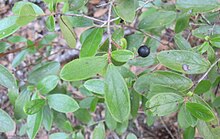
Vaccinium is a common and widespread genus of shrubs or dwarf shrubs in the heath family (Ericaceae). The fruits of many species are eaten by humans and some are of commercial importance, including the cranberry, blueberry, bilberry (whortleberry), lingonberry (cowberry), and huckleberry. Like many other ericaceous plants, they are generally restricted to acidic soils.

Xerophyllum asphodeloides is a North American species of flowering plants in the Melanthiaceae known by the common names turkey beard, eastern turkeybeard, beartongue, grass-leaved helonias, and mountain asphodel. It is native to the eastern United States, where it occurs in the southern Appalachian Mountains from Virginia to Alabama, and also in the Pine Barrens of New Jersey.

Gaylussacia is a genus of about fifty species of flowering plants in the family Ericaceae, native to the Americas, where they occur in eastern North America and in South America in the Andes and the mountains of southeastern Brazil. Common English names include huckleberry and "dangleberry".
"Blue huckleberry" refers to either of two plants native to North America:

Hoverter and Sholl Box Huckleberry Natural Area is a 10-acre (4.0 ha) natural area in Perry County, Pennsylvania, near New Bloomfield, which protects a colony of box huckleberry over 1,000 years old. The smallest Natural Area in Pennsylvania, it is administered as part of Tuscarora State Forest. It was designated a National Natural Landmark in April 1967.

Gaylussacia brachycera, commonly known as box huckleberry or box-leaved whortleberry, is a low North American shrub related to the blueberry and the other huckleberries. It is native to the east-central United States.

Quercus ilicifolia, commonly known as bear oak or scrub oak, is a small shrubby oak native to the eastern United States and southeastern Canada. Its range extends in the United States from Maine to North Carolina, with reports of a few populations north of the international frontier in Ontario. The name ilicifolia means "holly-leaved."
An oak–heath forest is a plant community association and type of forest ecology. It is a deciduous forest type of well-drained, acidic soils, characterized by oaks (Quercus) and plants of the heath family (Ericaceae). It is commonly found in the high elevations of the eastern United States. Such forest areas typically have a dense fibrous root layer at the surface of the soil, and in many areas predominate on south-facing or southwest-facing slopes. Many of the existing oak–heath forests once featured American chestnut as an important canopy species.

Gaylussacia baccata, the black huckleberry, is a common huckleberry found throughout a wide area of eastern North America.

Huckleberry is a name used in North America for several plants in the family Ericaceae, in two closely related genera: Vaccinium and Gaylussacia. The huckleberry is the state fruit of Idaho.
Black huckleberry is a common name for several plants and may refer to:

Vaccinium membranaceum is a species within the group of Vaccinium commonly referred to as huckleberry. This particular species is known by the common names thinleaf huckleberry, tall huckleberry, big huckleberry, mountain huckleberry, square-twig blueberry, and (ambiguously) as "black huckleberry".

Gaylussacia dumosa is a species of flowering plant in the heath family known by the common names dwarf huckleberry, bush huckleberry, and gopherberry. It is native to eastern North America from Newfoundland to Louisiana and Florida. It occurs along the coastal plain and in the mountains.

Gaylussacia frondosa is a species of flowering plant in the heath family known by the common names dangleberry and blue huckleberry. It is native to the eastern United States, where it occurs from New Hampshire to South Carolina.

Gaylussacia nana, the dwarf dangleberry or Confederate huckleberry, is a plant species native to the coastal plains of the southeastern United States. It has been reported from Louisiana, Alabama, Mississippi, Georgia, Florida, North Carolina and South Carolina. It is found in either wet or dry soil, in woodlands, bogs, sandy ridges and savannahs, usually at elevations less than 100 m.

Gaylussacia bigeloviana, the bog huckleberry, is a plant species native to the coastal plains of eastern Canada and the eastern United States. It grows from Newfoundland to South Carolina.
Gaylussacia orocola, the Blue Ridge huckleberry, is a plant species native to the coastal plains of the southeastern United States.
Gaylussacia tomentosa, commonly known as the hairy dangleberry or hairytwig huckleberry, is a plant species native to the coastal plains of the southeastern United States.
Gaylussacia ursina, the bear huckleberry, is a plant species native to the coastal plains of the southeastern United States, in the southern Appalachians of.
Bog huckleberry is a common name for several plants and may refer to:













